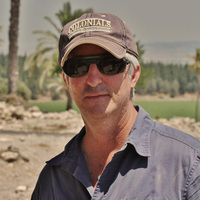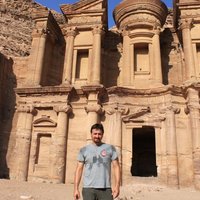Papers by Maria Fotiadi

Dedications at Dodona
The sanctuary of Dodona is located at the middle of a valley, between the imposing mountains of T... more The sanctuary of Dodona is located at the middle of a valley, between the imposing mountains of Tomaros and Manoliassa, a few miles away from the modern city of Ioannina at Epirus. Dodona was the oldest oracle of Ancient Greece and the religious and political center of the Epirotic tribes. The sanctuary was dedicated to Zeus Dodonaios and his wife Dione and the cult focused mainly on the sacred oak tree (ΦΗΓΟΣ). The archaeologists found a vast number of offerings, such as tripods, weapons, bronze statues etc. The presentation aims to shed light on these offerings and discuss the unique character of the cult practices as it can be seen from the archaeological and historical evidences. Moreover, it outlines important religious, political, social, and spatial factors that shaped the reputation of the oracle and affected drastically its fate and its course through time. The primitive cult practices, which survived and formed within the context of the Archaic and Classical Antiquity, pla...

Dedications at ancient Dodona
The sanctuary of Dodona, the oldest of the Greek world, is located a few miles away from the pres... more The sanctuary of Dodona, the oldest of the Greek world, is located a few miles away from the present city of Ioannina. The close proximity of the site to my birthplace, made me wish to study further the history and the cult of Dodona. The oracle had a long lasting history, with the early finds dating back to the 13th century BC, with a course of distinct presence until the 4th century AD, when the pagan cult was replaced by the Christian religion. From the 8th century onwards, Dodona had a certain Greek cult activity, with interesting and rich dedications: bronze statuettes, statues, ex-voto, vessels, and valuable offerings. However, the earlier finds (weapons, ceremonial axes, miniature clay vessels) signify a primitive cult activity. This thesis aims to present an overview of the offerings, interpret their significance, and reveal the character of the oracle through the finds. For the first time, a combined catalogue of more than 600 offerings, presents as a whole the variety of t...
The study used: Historical material such as ancient literature sources, excavation reports, cata... more The study used: Historical material such as ancient literature sources, excavation reports, catalogues from Museums (Antikensammlung Berlin, British Museum, Archaeological Museum of Ioannina, and National Archeological Museum of Athens) and modern bibliography as well various archaeological guides for Dodona. Archaeological material from excavations, for the creation of a catalogue with more than 200 offerings presented with a full description and images or sketches of the finds. Photos from the actual site of Dodona; maps of the area and 3D images of the sanctuary were used to reveal the various construction phases.
Thesis Chapters by Maria Fotiadi

The sanctuary of Dodona, the oldest of the Greek world, is located a few miles away from the pres... more The sanctuary of Dodona, the oldest of the Greek world, is located a few miles away from the present city of Ioannina. The close proximity of the site to my birthplace, made me wish to study further the history and the cult of Dodona. The oracle had a long lasting history, with the early finds dating back to the 13th century BC, with a course of distinct presence until the 4th century AD, when the pagan cult was replaced by the Christian religion. From the 8th century onwards, Dodona had a certain Greek cult activity, with interesting and rich dedications: bronze statuettes, statues, ex-voto, vessels, and valuable offerings. However, the earlier finds (weapons, ceremonial axes, miniature clay vessels) signify a primitive cult activity.
This thesis aims to present an overview of the offerings, interpret their significance, and reveal the character of the oracle through the finds. For the first time, a combined catalogue of more than 600 offerings, presents as a whole the variety of the finds. Moreover, I tried to explore the factors that affected the identity of the oracle and highlight the connection of Dodona with other areas or individuals. The decline of the sanctuary came with the Roman Invasion in 167 BC. Therefore, I had to stop at that point, when the evidence was limited and vague.
Drafts by Maria Fotiadi
Hilarion Mine
X-Ray Magazine #96, Jan 23, 2020
In May 2019, a group of dry cavers visited the famous silver mines of Laurion, in the South-East ... more In May 2019, a group of dry cavers visited the famous silver mines of Laurion, in the South-East Region of Attica (Greece). The main objective of this visit was to inspect and document the flooded chambers. And the journey of the underwater exploration began…. (pg.73)
https://xray-mag.com/content/hilarion-exploring-greek-silver-mines-lavreotiki











Uploads
Papers by Maria Fotiadi
Thesis Chapters by Maria Fotiadi
This thesis aims to present an overview of the offerings, interpret their significance, and reveal the character of the oracle through the finds. For the first time, a combined catalogue of more than 600 offerings, presents as a whole the variety of the finds. Moreover, I tried to explore the factors that affected the identity of the oracle and highlight the connection of Dodona with other areas or individuals. The decline of the sanctuary came with the Roman Invasion in 167 BC. Therefore, I had to stop at that point, when the evidence was limited and vague.
Drafts by Maria Fotiadi
https://xray-mag.com/content/hilarion-exploring-greek-silver-mines-lavreotiki
This thesis aims to present an overview of the offerings, interpret their significance, and reveal the character of the oracle through the finds. For the first time, a combined catalogue of more than 600 offerings, presents as a whole the variety of the finds. Moreover, I tried to explore the factors that affected the identity of the oracle and highlight the connection of Dodona with other areas or individuals. The decline of the sanctuary came with the Roman Invasion in 167 BC. Therefore, I had to stop at that point, when the evidence was limited and vague.
https://xray-mag.com/content/hilarion-exploring-greek-silver-mines-lavreotiki